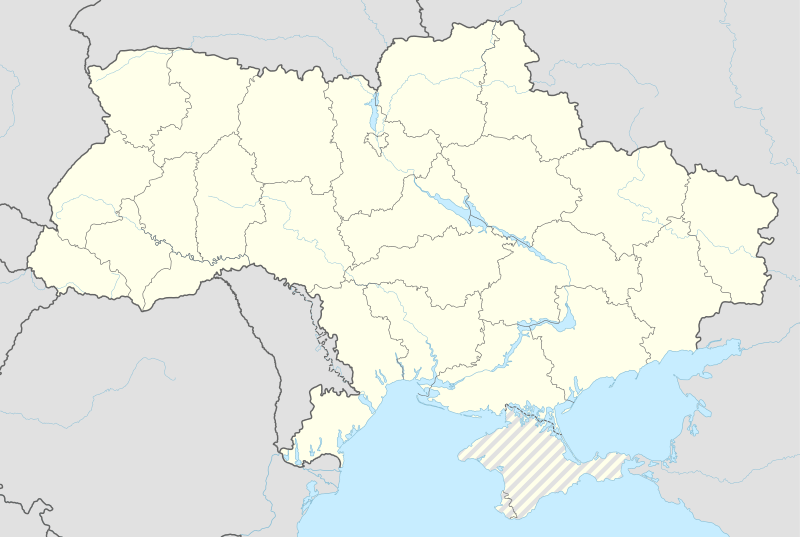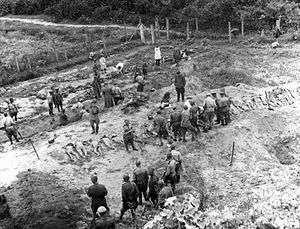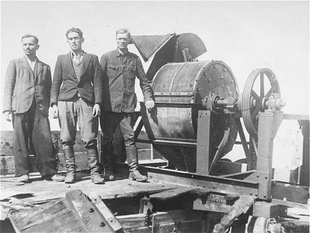Janowska concentration camp
| Janowska concentration camp | |
|---|---|
| Concentration camp | |
|
Sonderkommando 1005 next to a bone crushing machine during liquidation of genocide evidence in the Janowska concentration camp | |
 Location of Janowska camp in modern Ukraine
Janowska
Location of KL Janowska in World War II, | |
| Coordinates | 49°51′15″N 23°59′24″E / 49.85417°N 23.99000°ECoordinates: 49°51′15″N 23°59′24″E / 49.85417°N 23.99000°E |
| Location | Lwów, occupied Poland (today Lviv, Ukraine) |
| Operated by | Schutzstaffel (SS) |
| Original use | Civilian internment camp |
| Operational | September 1941 – November 1943 |
| Inmates | Jews |
| Number of inmates | 100,000 |
| Liberated by | The Red Army |
| Website | Janowska – Lvov |
Janowska concentration camp (Polish: Janowska, Russian: Янов or "Yanov", Ukrainian: Янівський табір) was a Nazi German labor, transit and extermination camp established in September 1941 in occupied Poland on the outskirts of Lwów (Second Polish Republic, today Lviv in Ukraine). The camp was labeled Janowska after the nearby street ulica Janowska in Lwów, renamed Shevchenka (Ukrainian: Шевченка) after the city was ceded to the Ukrainian SSR. The camp was liquidated in November 1943. The Extraordinary State Commission notorious for exaggerating the Soviet losses after World War II claimed that up to 200,000 victims perished there; according to Soviet prosecutor at the Nuremberg Trials, Janowska was an extermination camp. Nevertheless, modern estimates put the total number of prisoners who passed through Janowska at over 100,000.[1]
Background – the Lwów Ghetto
After the Nazi-Soviet invasion of Poland at the beginning of World War II, the city of Lwów in the Second Polish Republic (now Lviv, Ukraine) was occupied in September 1939 by the Soviet Union under the terms of the Ribbentrop-Molotov Pact. At that time, there were over 330,000 Jews residing in Lwów, including over 90,000 Jewish children and infants. Over 150,000 of them were refugees from the German-occupied western part of the Poland. In June 1941, the German Army took over Lwów in the course of the initially successful attack on the Soviet positions in eastern Poland, known as Operation Barbarossa. Almost no Jews of Lwów were alive at the end of the war, many being horrifically tormented and tortured before they were murdered.[2][3]
The retreating Soviets killed about 7,000 Polish and Ukrainian civilians in June during the NKVD prisoner massacres in Lwów. The victims were held in three prisons: Brygidki, Zamarstynów, and Łąckiego Street prison. The invading Germans blamed the NKVD massacre on the Soviet Jews in the NKVD ranks, and used the atrocity as propaganda tool to incite the first pogrom in which over 4,000 Polish Jews were killed between 30 June and 2 July 1941 by Ukrainian nationalists. A further 2,500 to 3,000 Jews were murdered by the German Einsatzgruppen.[4] The arrival of the Nazis let loose a wave of antisemitic feelings. Encouraged by German forces, local Ukrainian nationalists murdered additional 5,500 Jews during the second Lviv pogrom in 25–27 July 1941. It was known as the "Petliura Days", named for the nationalist leader Symon Petliura. For three straight days, Ukrainian militants went on a murderous rampage through the Jewish districts of Lwów. Groups of Jews were herded out to the Jewish cemetery and to the prison on Łąckiego street where they were killed. More than 2,000 Jews died and thousands more were injured.[5][6]
In early November 1941, the Nazis closed-off northern portions of the city of Lwów thus forming a ghetto.[7] German police shot and killed thousands of elderly and sick Jews as they crossed under the rail bridge on Pełtewna Street (which was called bridge of death by Jews), while they were on their way to the ghetto. In March 1942, the Nazis began to deport Jews from the ghetto to the Belzec extermination camp. By August 1942, more than 65,000 Jews had been deported from Lwów and killed. In early June 1943, the Germans destroyed and liquidated the ghetto.[8]
The Janowska labour and transit camp
In addition to the Lwów ghetto, in September 1941, the Germans set up a D.A.W. (Deutsche Ausrüstungswerke – the German Armament Works) workshop in prewar Steinhaus' mill machines factory on 134 Janowska Street, in northwestern suburbs of Lwów (at that time in German-occupied southeastern Poland, now in western Ukraine). This factory became a part of a network of factories, owned and operated by the SS. The commandant of the camp was SS-Haupsturmführer Fritz Gebauer. Jews who worked at this factory were used as forced laborers, mainly working in carpentry and metalwork.
In October 1941, the Nazis established a concentration camp beside the factory, which housed the forced laborers along with the rest of the prisoners. Thousands of Jews from the Lwów ghetto were forced to work as slave laborers in this camp. When the Lwów ghetto was liquidated by the Nazis, the ghetto's inhabitants who were fit for work were sent to the Janowska camp; the rest were deported to the Belzec for extermination. The concentration camp was guarded by a Sonderdienst battalion of the SS-trained Hiwi police guards known as "Trawniki men".[9]
In addition to being a forced-labor camp for Jews, Janowska was a transit camp (Durchgangslager Janowska) during the mass deportations of Polish Jews to the killing centers in 1942. Jews underwent a selection process in Janowska camp similar to that used at Auschwitz-Birkenau and Majdanek extermination camps. Those classified as fit to work remained at Janowska for forced labor. The majority, rejected as unfit for work, were deported to Belzec and killed, or else were shot at the Piaski ravine, located just north of the camp. In the summer and fall of 1942, thousands of Jews (mainly from the Lwów ghetto) were deported to Janowska and killed in the Piaski ravine.
The Nazis occasionally allowed small groups of Jews to go to town for daylong leaves of absence. They would use this temporary freedom to dig up Torahs that had been hidden in Lwów's Jewish cemetery. The Torahs were then cut into pieces which were hidden under their clothes and smuggled back into the camp. After the war the various pieces were assembled into a single scroll, the Yanov torah, which is currently in California.[10]

Liquidation of the Janowska camp
Ahead of the Soviet advance, in November 1943 the new camp commandant SS-Hauptsturmführer Friedrich Warzok was put in charge of the evacuation of the Janowska inmates to Przemyśl.[11] The Germans attempted to destroy the traces of mass murder during Sonderaktion 1005. Prisoners were forced to open the mass graves in Lesienicki forest and burn the bodies. On November 19, 1943, the Sonderkommando inmates staged a revolt against the Nazis and attempted a mass escape. A few succeeded, but most were recaptured and killed. The SS and their local auxiliaries murdered at least 6,000 Jews who had survived the uprising killings at Janowska, as well as Jews in other forced labor camps in Galicia, at the time of the camps' liquidation.
The Soviet Extraordinary State Commission determined that over 200,000 people were killed in Janowska in the course of the camp operation. The ashes mixed with crushed bones were buried to a depth of six feet in various places.[12] Leon Weliczker Wells told the Commission that between June 6 and November 20, 1943 his "team burned more than 310,000 bodies" including 170,000 in the immediate vicinity of the camp and another 140,000 or more in the Lysynychi area of eastern Lwów.[13] Weliczker repeated the claim of "a few hundred thousand" at Adolf Eichmann's trial in 1961.[14] Weliczker also described his work as part of the Sonderaktion 1005 in his book Death Brigade.
The Commission's reliability has been disputed, however, as politically motivated. When Nikolay Burdenko was chairman of the Extraordinary State Commission for the Katyn massacre, for example, his report was later acknowledged to be an outright falsfication that sought to falsely attribute a Soviet war crime to the Germans.[15] Janowska served as a Soviet prison camp after its liberation.[12]
Notable inmates
- Adolf Beck, Polish physiologist
- Rabbi Yisroel Spira, Grand Rabbi of Bluzev (Błażowa)
- Emanuel Szlechter, Polish screenwriter and lyricist
- William Ungar, founder of the National Envelope Corporation
- Simon Wiesenthal, Nazi hunter
See also
- List of Nazi-German concentration camps
- Kaiser Wilhelm Institute of Anthropology, Human Heredity, and Eugenics
- Research Materials: Max Planck Society Archive
References
- ↑ Emil Kerenji (2014). Jewish Responses to Persecution: 1942–1943. Rowman & Littlefield. p. 69. ISBN 1442236272.
- ↑ Anna Gałkiewicz (2001), Informacja o śledztwach prowadzonych w OKŚZpNP w Łodzi w sprawach o zbrodnie popełnione przez funkcjonariuszy sowieckiego aparatu terroru; Institute of National Remembrance Biuletyn, Vol. 7 – August 2001. (Polish)
- ↑ Nagorski, Andrew. The Greatest Battle (Google Books). Simon and Schuster. p. 83. Retrieved 2015-02-15.
- ↑ N.M.T. (1945). "Trials of War Criminals before the Nuernberg Military Tribunals" (PDF direct download). Volume IV : "The Einsatzgruppen Case" complete, 1210 pages. Nuremberg Military Tribunals under Control Council Law No. 10. pp. 542–543 in PDF (518–519 in original document). Retrieved 1 March 2015.
With N.M.T. commentary to testimony of Erwin Schulz (p. 543 in PDF).
- ↑ Longerich, Peter (2010). Holocaust: The Nazi Persecution and Murder of the Jews. Oxford; New York: Oxford University Press. p. 194. ISBN 978-0-19-280436-5.
- ↑ USHMM. "Lwów". Holocaust Encyclopedia. United States Holocaust Memorial Museum. Archived from the original (Internet Archive) on March 7, 2012. Retrieved 4 March 2015.
- ↑ Claudia Koonz (November 2, 2005). "SS Man Katzmann's "Solution of the Jewish Question in the District of Galicia"" (PDF). The Raul Hilberg Lecture. University of Vermont: 2, 11, 16–18. Retrieved 30 January 2015.
- ↑ Filip Friedman, Zagłada Żydów lwowskich (Extermination of the Jews of Lwów) OCLC 38706656.
- ↑ Holocaust Encyclopedia. "Trawniki" (permission granted to be reused, in whole or in part, on Wikipedia; OTRS ticket no. 2007071910012533). United States Holocaust Memorial Museum. Retrieved July 21, 2011.
Text from USHMM has been released under the GFDL.
- ↑ Erwin and Agnes Herman The Yanov Torah Kar-Ben Publishing ISBN 978-0930494452 (1985)
- ↑ Levy, Alan (2006) [1993]. Nazi Hunter: The Wiesenthal File (Revised 2002 ed.). London: Constable & Robinson. ISBN 978-1-84119-607-7.
- 1 2 Carmelo Lisciotto, H.E.A.R.T (2007). "The Soviet Special Commission". Janowska – Lvov. Holocaust Education & Archive Research Team. Retrieved June 19, 2013.
- ↑ Avner Falk Anti-semitism: A History and Psychoanalysis of Contemporary Hatred ABC-CLIO ISBN 9780313353840 (2008) p. 191
- ↑ "The Trial of Adolf Eichmann" Session #23 2 May 1961
- ↑ Fischer, Benjamin B., "The Katyn Controversy: Stalin's Killing Field". "Studies in Intelligence", Winter 1999–2000. Retrieved August 17, 2013.
- Aharon Weiss, Encyclopaedia of the Holocaust (Hebrew edition), vol. 3, pp. 572–575. Map, illustration
- Filip Friedman, Zagłada Żydów Lwowskich (Extermination of the Jews of Lwów) – online in Polish, Ukrainian and Russian
External links
| Wikimedia Commons has media related to Janowska Nazi camp. |
- US Holocaust Memorial Museum Website (Search: "Janowska")
- Eichmann Trial transcript: Testimony of Dr. Leon Weliczker-Wells (part 1 of 5) – navigate consecutive web pages within website
- Story of Nina Morecki, who was imprisoned in Janowska in 1942; photo page has images of boulder memorial at site of mass executions
- The HolocaustResesearchProject
